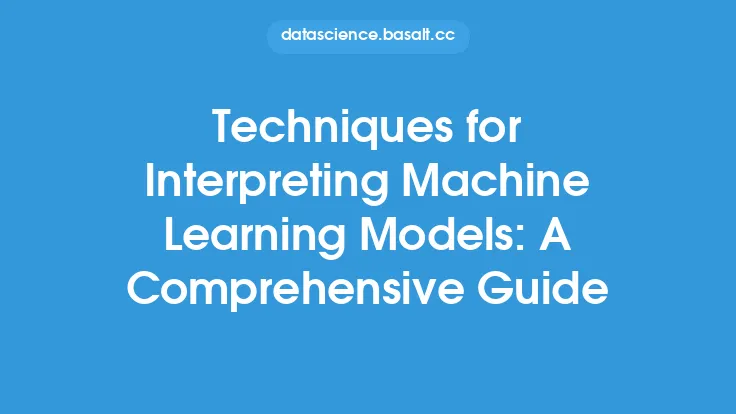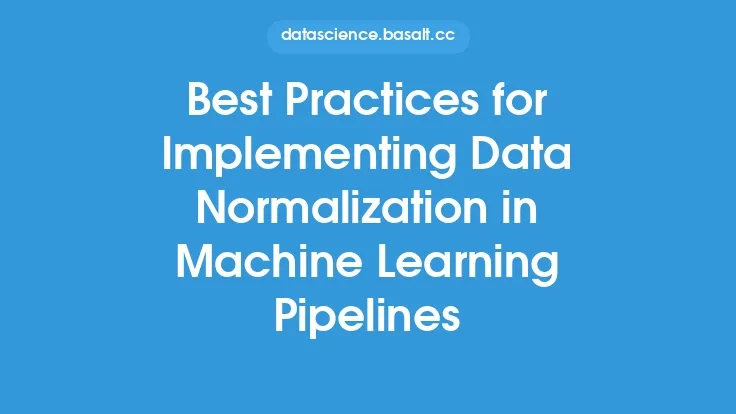When it comes to training machine learning models, hyperparameter tuning is a crucial step that can significantly impact the performance of the model. Hyperparameters are parameters that are set before training the model, and they can have a significant impact on the model's ability to generalize to new data. In this article, we will discuss the best practices for hyperparameter tuning, including how to approach the problem, how to evaluate different hyperparameter settings, and how to select the best hyperparameters for a given model.
Understanding Hyperparameters
Hyperparameters are parameters that are set before training a machine learning model, and they can have a significant impact on the model's performance. Examples of hyperparameters include the learning rate, regularization strength, and number of hidden layers in a neural network. Hyperparameters can be categorized into two main types: model hyperparameters and algorithm hyperparameters. Model hyperparameters are parameters that are specific to the model, such as the number of hidden layers in a neural network. Algorithm hyperparameters, on the other hand, are parameters that are specific to the algorithm used to train the model, such as the learning rate or batch size.
Approaching Hyperparameter Tuning
Hyperparameter tuning can be a challenging problem, especially when dealing with large datasets and complex models. One approach to hyperparameter tuning is to use a grid search, which involves trying out all possible combinations of hyperparameters and selecting the best one. However, this approach can be computationally expensive and may not be feasible for large datasets. Another approach is to use a random search, which involves randomly sampling the hyperparameter space and selecting the best hyperparameters. This approach can be more efficient than grid search, but it may not always find the optimal hyperparameters.
Evaluating Hyperparameter Settings
Evaluating different hyperparameter settings is a critical step in hyperparameter tuning. One common approach is to use cross-validation, which involves splitting the data into training and validation sets and evaluating the model's performance on the validation set. This approach can help to prevent overfitting and ensure that the model generalizes well to new data. Another approach is to use a holdout set, which involves holding out a portion of the data and using it to evaluate the model's performance. This approach can be more efficient than cross-validation, but it may not provide as accurate an estimate of the model's performance.
Selecting the Best Hyperparameters
Selecting the best hyperparameters for a given model can be a challenging problem. One approach is to use a metric such as accuracy or mean squared error to evaluate the model's performance. However, this approach may not always be effective, especially when dealing with imbalanced datasets. Another approach is to use a metric such as area under the receiver operating characteristic curve (AUC-ROC) or area under the precision-recall curve (AUC-PR), which can provide a more nuanced evaluation of the model's performance.
Hyperparameter Tuning for Deep Learning Models
Hyperparameter tuning for deep learning models can be particularly challenging due to the large number of hyperparameters that need to be tuned. One approach is to use a hierarchical approach, which involves tuning the most important hyperparameters first and then tuning the less important hyperparameters. Another approach is to use a Bayesian optimization approach, which involves using a probabilistic model to search for the optimal hyperparameters. This approach can be more efficient than traditional grid search or random search approaches, but it may require significant computational resources.
Hyperparameter Tuning for Transfer Learning
Hyperparameter tuning for transfer learning can be challenging due to the need to balance the trade-off between the pre-trained model and the new data. One approach is to use a fine-tuning approach, which involves fine-tuning the pre-trained model on the new data. Another approach is to use a feature extraction approach, which involves using the pre-trained model as a feature extractor and training a new model on top of the extracted features. Hyperparameter tuning for transfer learning requires careful consideration of the pre-trained model's hyperparameters and the new data's hyperparameters.
Common Hyperparameter Tuning Mistakes
There are several common mistakes that can be made when performing hyperparameter tuning. One mistake is to overfit the hyperparameters to the training data, which can result in poor performance on new data. Another mistake is to underfit the hyperparameters, which can result in suboptimal performance. Additionally, hyperparameter tuning can be computationally expensive, and it is important to carefully consider the computational resources required for hyperparameter tuning.
Best Practices for Hyperparameter Tuning
There are several best practices that can be followed when performing hyperparameter tuning. One best practice is to use cross-validation to evaluate the model's performance, which can help to prevent overfitting. Another best practice is to use a random search approach, which can be more efficient than grid search. Additionally, it is important to carefully consider the hyperparameter space and to use a probabilistic approach to search for the optimal hyperparameters. Finally, it is important to carefully evaluate the model's performance on a holdout set to ensure that the model generalizes well to new data.
Conclusion
Hyperparameter tuning is a critical step in training machine learning models, and it can have a significant impact on the model's performance. By following best practices such as using cross-validation, random search, and probabilistic approaches, it is possible to effectively tune hyperparameters and improve the model's performance. Additionally, careful consideration of the hyperparameter space and the model's performance on a holdout set can help to ensure that the model generalizes well to new data. By avoiding common mistakes such as overfitting and underfitting, it is possible to achieve optimal performance from machine learning models.





